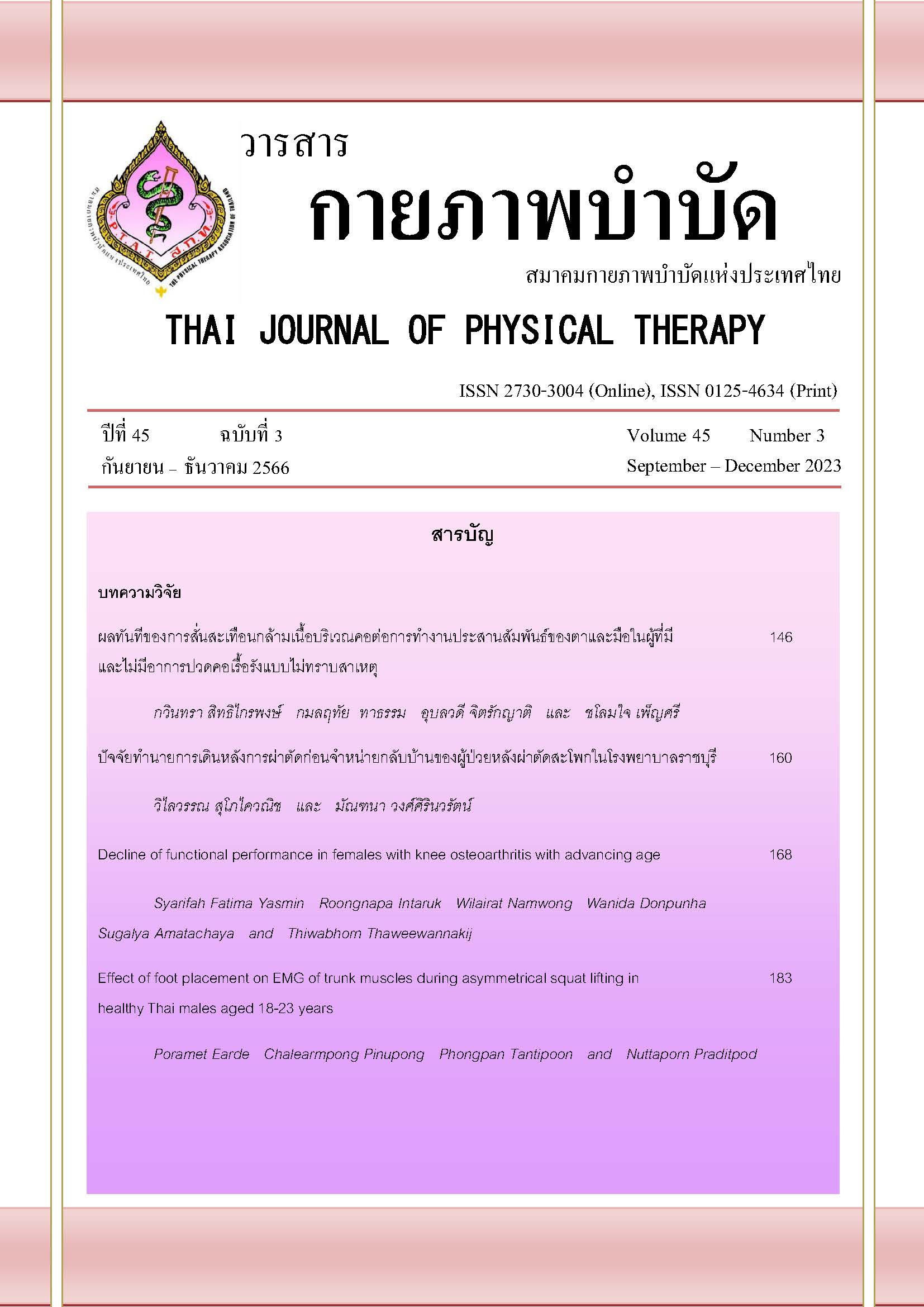ผลทันทีของการสั่นสะเทือนกล้ามเนื้อบริเวณคอต่อการทำงานประสานสัมพันธ์ของตาและมือในผู้ที่มีและไม่มีอาการปวดคอเรื้อรังแบบไม่ทราบสาเหตุ
Main Article Content
บทคัดย่อ
ที่มาและความสำคัญ: การสั่นสะเทือนกล้ามเนื้อคอส่งผลให้การกะระยะของแขนและการรับรู้ตำแหน่งของข้อต่อซึ่งเป็นส่วนหนึ่งของการทำงานประสานสัมพันธ์ของตาและมือดีขึ้น ดังนั้น การสั่นสะเทือนกล้ามเนื้อบริเวณคออาจส่งผลต่อการทำงานประสานสัมพันธ์ของตาและมือ เพื่อให้เข้าใจถึงผลกระทบของการสั่นสะเทือนของกล้ามเนื้อคอต่อการประสานสัมพันธ์ของตาและมือในผู้ที่มีและไม่มีอาการปวดคอเรื้อรังแบบไม่ทราบสาเหตุมากยิ่งขึ้น จึงจำเป็นต้องมีการศึกษาเพื่อตรวจสอบผลของการสั่นสะเทือนเหล่านี้
วัตถุประสงค์: เพื่อศึกษาผลการสั่นสะเทือนของกล้ามเนื้อบริเวณคอต่อการทำงานประสานสัมพันธ์ของตาและมือในผู้ที่มีและไม่มีอาการปวดคอเรื้อรังแบบไม่ทราบสาเหตุ
วิธีการวิจัย: ผู้ที่มีอาการปวดคอเรื้อรังแบบไม่ทราบสาเหตุ 17 คน และผู้ที่ไม่มีอาการปวด 17 คน ทำการทดสอบ The Lee-Ryan eye-hand coordination test ที่มีระดับความยากสามระดับ คือ ระดับง่าย ปานกลาง และยาก หลังจากนั้นจะได้รับการสั่นบริเวณกล้ามเนื้อคอและกลับมาทำการทดสอบ The Lee-Ryan eye-hand coordination test ซ้ำอีกครั้งทันที
ผลการวิจัย: ไม่มีความแตกต่างกันของการทำงานประสานสัมพันธ์ของตาและมือระหว่างกลุ่มก่อนและหลังการสั่นสะเทือนกล้ามเนื้อบริเวณคอ (p > 0.05) อย่างไรก็ตาม การศึกษาภายในกลุ่มแสดงให้เห็นถึงค่าตัวแปรระยะเวลาและจำนวนความผิดพลาดในระดับความยากทั้งสามระดับภายหลังการสั่นสะเทือนกล้ามเนื้อบริเวณคอดีขึ้นกว่าก่อนการสั่นสะเทือนกล้ามเนื้อบริเวณคอทั้งสองกลุ่มอย่างมีนัยสำคัญทางสถิติ (p < 0.01)
สรุปผล: การทำงานประสานสัมพันธ์ของตาและมือระหว่างกลุ่มทั้งก่อนและหลังการสั่นสะเทือนกล้ามเนื้อบริเวณคอไม่มีความแตกต่างกัน อย่างไรก็ตาม การสั่นสะเทือนกล้ามเนื้อคอนั้นทำให้การทำงานประสานสัมพันธ์ของตาและมือดีขึ้นในทั้งสองกลุ่ม การศึกษาครั้งถัดไปควรศึกษาผลระยะยาวของการสั่นสะเทือนกล้ามเนื้อบริเวณคอในประชากรกลุ่มนี้เพิ่มเติม
Article Details

อนุญาตภายใต้เงื่อนไข Creative Commons Attribution-NonCommercial-NoDerivatives 4.0 International License.
เอกสารอ้างอิง
Janwantanakul P, Pensri P, Jiamjarasrangsri V, Sinsongsook T. Prevalence of self-reported musculoskeletal symptoms among office workers. Occup Med (Lond). 2008;58(6):436-8.
Kanchanomai S, Janwantanakul P, Pensri P, Jiamjarasrangsi W. Risk factors for the onset and persistence of neck pain in undergraduate students: 1-year prospective cohort study. BMC Public Health. 2011; 11: 566.
Haldeman S, Carroll L, Cassidy JD, Schubert J, Nygren A. The bone and joint decade 2000-2010 task force on neck pain and its associated disorders: executive summary. J Manipulative Physiol Ther. 2009; 32(2 Suppl): S7-9.
Sittikraipong K, Silsupadol P, Uthaikhup S. Slower reaction and response times and impaired hand-eye coordination in individuals with neck pain. Musculoskelet Sci Pract. 2020; 50: 102273.
Kristjansson E, Treleaven J. Sensorimotor function and dizziness in neck pain: implications for assessment and management. J Orthop Sports Phys Ther. 2009; 39(5): 364-77.
Treleaven J. Dizziness, unsteadiness, visual disturbances, and sensorimotor control in traumatic neck pain. J Orthop Sports Phys Ther. 2017; 47(7): 492-502.
Treleaven J. Sensorimotor disturbances in neck disorders affecting postural stability, head and eye movement control. Man Ther. 2008; 13(1): 2-11.
Treleaven J, Takasaki H. Characteristics of visual disturbances reported by subjects with neck pain. Man Ther. 2014; 19(3): 203-7.
Uthaikhup S, Sunkarat S, Khamsaen K, Meeyan K, Treleaven J. The effects of head movement and walking speed on gait parameters in patients with chronic neck pain. Man Ther. 2014; 19(2): 137-41.
Binsted G, Chua R, Helsen W, Elliott D. Eye–hand coordination in goal-directed aiming. Hum Mov Sci. 2001; 20(4): 563-85.
van Beers RJ, Sittig AC, Gon JJ. Integration of proprioceptive and visual position-information: an experimentally supported model. J Neurophysiol. 1999; 81(3): 1355-64.
Peterson BW. Current approaches and future directions to understanding control of head movement. Prog Brain Res. 2004; 143: 369-81.
Mergner T, Schweigart G, Botti F, Lehmann A. Eye movements evoked by proprioceptive stimulation along the body axis in humans. Exp Brain Res. 1998; 120(4): 450-60.
Yamagata Y, Yates BJ, Wilson VJ. Participation of Ia reciprocal inhibitory neurons in the spinal circuitry of the tonic neck reflex. Exp Brain Res. 1991; 84(2): 461-4.
Kulkarni V, Chandy MJ, Babu KS. Quantitative study of muscle spindles in suboccipital muscles of human foetuses. Neurol India. 2001; 49(4): 355-9.
Roll JP, Vedel JP, Ribot E. Alteration of proprioceptive messages induced by tendon vibration in man: a microneurographic study. Exp Brain Res. 1989; 76(1): 213-22.
Beinert K, Englert V, Taube W. After-effects of neck muscle vibration on sensorimotor function and pain in neck pain patients and healthy controls - a case-control study. Disabil Rehabil. 2019; 41(16): 1906-13.
Wannaprom N, Treleaven J, Jull G, Uthaikhup S. Neck muscle vibration produces diverse responses in balance and gait speed between individuals with and without neck pain. Musculoskelet Sci Pract. 2018; 35: 25-9.
Jamal K, Leplaideur S, Leblanche F, Moulinet Raillon A, Honoré T, Bonan I. The effects of neck muscle vibration on postural orientation and spatial perception: a systematic review. Neurophysiol Clin. 2020; 50(4): 227-67.
Beinert K, Keller M, Taube W. Neck muscle vibration can improve sensorimotor function in patients with neck pain. Spine J. 2015; 15(3): 514-21.
Turkmen C, Kose N, Bilgin S, Cetin H, Dulger E, Altin B, et al. Effects of local vibration and cervical stabilization exercises on balance, joint position sense, and isometric muscle performance in young adults: a randomized controlled study. Isokinet Exerc Sci. 2020; 28: 401-14.
Hwang S, Agada P, Kiemel T, Jeka JJ. Dynamic reweighting of three modalities for sensor fusion. PLoS One. 2014; 9(1): e88132.
Uthaikhup S, Paungmali A, Pirunsan U. Validation of Thai versions of the Neck Disability Index and Neck Pain and Disability Scale in patients with neck pain. Spine (Phila Pa 1976). 2011; 36(21): E1415-21.
Boonstra AM, Schiphorst Preuper HR, Balk GA, Stewart RE. Cut-off points for mild, moderate, and severe pain on the visual analogue scale for pain in patients with chronic musculoskeletal pain. Pain. 2014; 155(12): 2545-50.
Lee K, Junghans B, Ryan M, Khuu S, Suttle C. Development of a novel approach to the assessment of eye-hand coordination. J Neurosci Methods. 2014; 228: 50-6
Richardson JTE. Eta squared and partial eta squared as measures of effect size in educational research. Educ Res Rev. 2011; 6(2): 135-47.
Fritz CO, Morris PE, Richler JJ. Effect size estimates: current use, calculations, and interpretation. J Exp Psychol Gen. 2012; 141(1): 2-18.
Cohen J. Statistical power analysis for the behavioral sciences 2nd ed. Hillsdale: Earlbaum L, Associates; 1988.
Junghans BM, Khuu SK. Populations norms for "SLURP"-an ipad app for quantification of visuomotor coordination testing. Front Neurosci. 2019; 13: 711.
Sittikraipong K, Uthaikhup S. Relationships between clinical features of neck pain and reaction and response times in individuals with chronic neck pain. J Assoc Med Sci. 2019; 52(3): 212-8.
Carey DP. Eye-hand coordination: eye to hand or hand to eye? Curr Biol. 2000; 10(11): R416-9.
Bekkering H, Sailer U. Commentary: coordination of eye and hand in time and space. Prog Brain Res. 2002; 140: 365-73.
Sandlund J, Röijezon U, Björklund M, Djupsjöbacka M. Acuity of goal-directed arm movements to visible targets in chronic neck pain. J Rehabil Med. 2008; 40(5): 366-74.
Cerciello S, Rossi S, Visonà E, Corona K, Oliva F. Clinical applications of vibration therapy in orthopaedic practice. Muscles Ligaments Tendons J. 2016; 6(1): 147-56.


